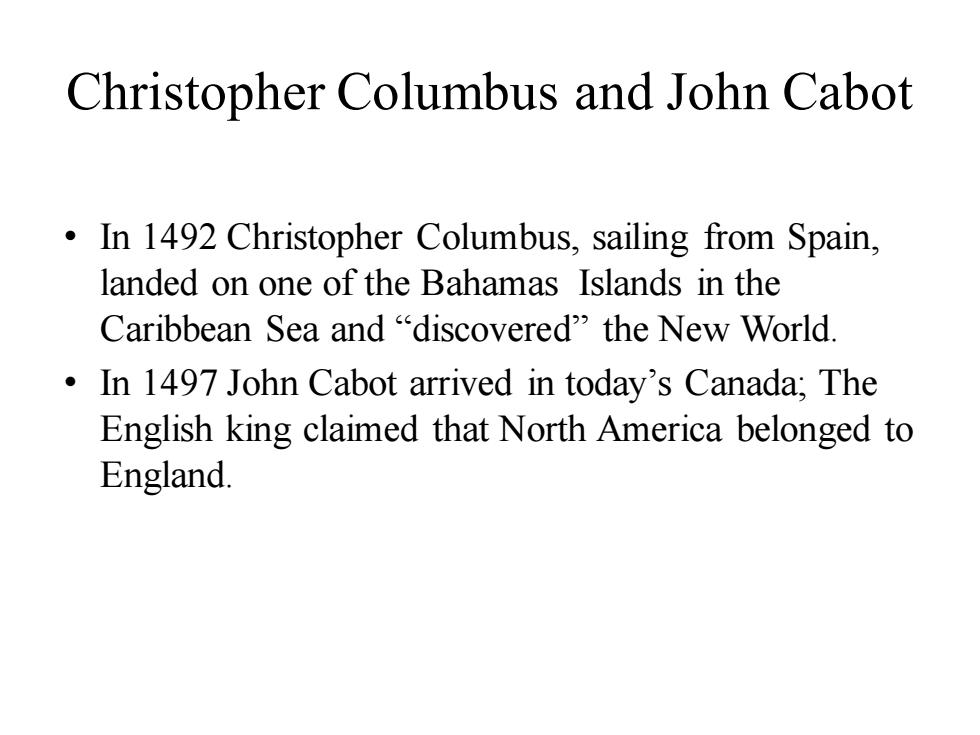
The United States ofAmerica Unit 3 American Beginnings
The United States of America Unit 3 American Beginnings

Quiz Give the English and a brief explanation for the following: 1马丁.路德 2哥伦布 3清教徒 4五月花公约 5波士顿倾茶事件
Quiz Give the English and a brief explanation for the following: 1 马丁· 路德 2 哥伦布 3 清教徒 4 五月花公约 5 波士顿倾茶事件

Focal Points The discovery of the Americas The Three forces that led to the development of Europe and the English permanent settlements in North America The four colonial patterns in North America -Jamestown,Virginia -Puritan New England -Catholic Maryland -Quaker Pennsylvania The American Revolution
Focal Points • The discovery of the Americas • The Three forces that led to the development of Europe and the English permanent settlements in North America • The four colonial patterns in North America -Jamestown, Virginia -Puritan New England -Catholic Maryland -Quaker Pennsylvania • The American Revolution

This Unit Is Divided into Four Sections I.The Discovery of the Americas II.The Three Forces that Led to the Development of Europe and the English Permanent Settlements of Europeans in North America III.The Four Colonial Patterns in North America IV.The American Revolution
This Unit Is Divided into Four Sections I. The Discovery of the Americas II. The Three Forces that Led to the Development of Europe and the English Permanent Settlements of Europeans in North America III. The Four Colonial Patterns in North America IV. The American Revolution

I.The Discovery of the Americas The first long-continuing immigration movement to the Americas from Asia began probably 25000 years ago,and Siberian tribes crossed over the Bering Strait to Alaska, mistakenly called Indians (The second immigration movement from Europe began with the expansion of Europe from the 16th century)
I. The Discovery of the Americas • The first long-continuing immigration movement to the Americas from Asia began probably 25000 years ago, and Siberian tribes crossed over the Bering Strait to Alaska, mistakenly called Indians (The second immigration movement from Europe began with the expansion of Europe from the 16th century)

Christopher Columbus and John Cabot In 1492 Christopher Columbus,sailing from Spain, landed on one of the Bahamas Islands in the Caribbean Sea and "discovered"the New World. In 1497 John Cabot arrived in today's Canada;The English king claimed that North America belonged to England
Christopher Columbus and John Cabot • In 1492 Christopher Columbus, sailing from Spain, landed on one of the Bahamas Islands in the Caribbean Sea and “discovered” the New World. • In 1497 John Cabot arrived in today’s Canada; The English king claimed that North America belonged to England

Christopher Columbus (left)and John Cabot (right)
Christopher Columbus (left) and John Cabot (right)

II.The Three Forces that Led to the Development of Europe and the English Permanent Settlements of Europeans in North America A.The development of capitalism in the 16th and 17th centuries and growth of the bourgeoisie and working class
II. The Three Forces that Led to the Development of Europe and the English Permanent Settlements of Europeans in North America A. The development of capitalism in the 16th and 17th centuries and growth of the bourgeoisie and working class

II.The Three Forces that Led to the Development of Europe and the English Permanent Settlements of Europeans in North America B.The Renaissance (from the mid 14th to the end of the 16th century God-centered world challenged; ● authority of the Bible challenged; changing outlook on life; the burst of creativity in the fine arts; flourishing in the literary sphere; expansion of scientific and philosophical horizons
II. The Three Forces that Led to the Development of Europe and the English Permanent Settlements of Europeans in North America B. The Renaissance (from the mid 14th to the end of the 16th century • God-centered world challenged; • authority of the Bible challenged; • changing outlook on life; • the burst of creativity in the fine arts; • flourishing in the literary sphere; • expansion of scientific and philosophical horizons

Renaissance Leonardo da Vinci Nicolaus Copernicus
Renaissance Leonardo da Vinci Nicolaus Copernicus